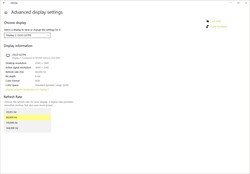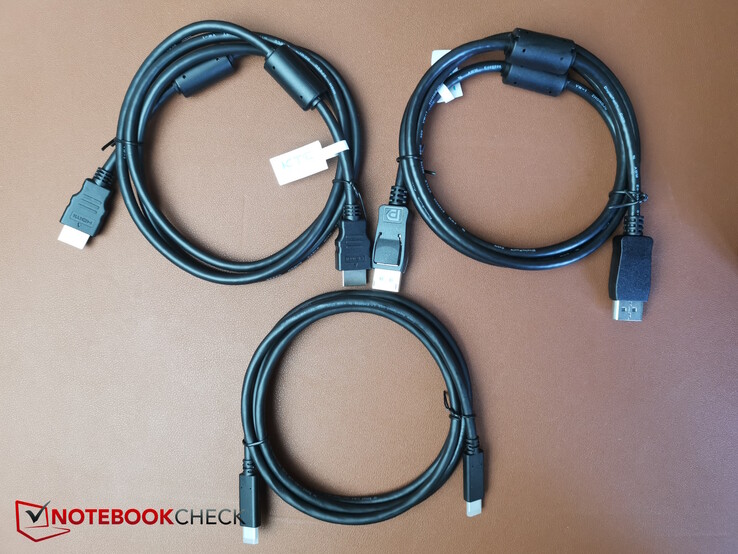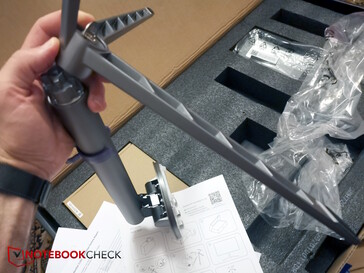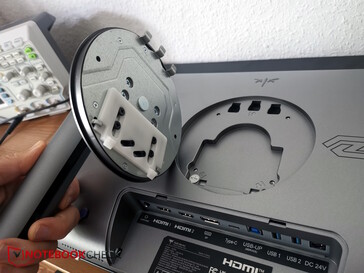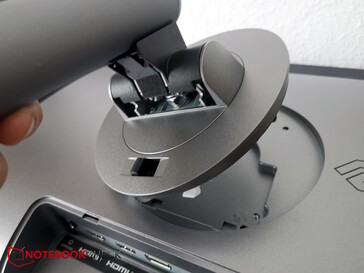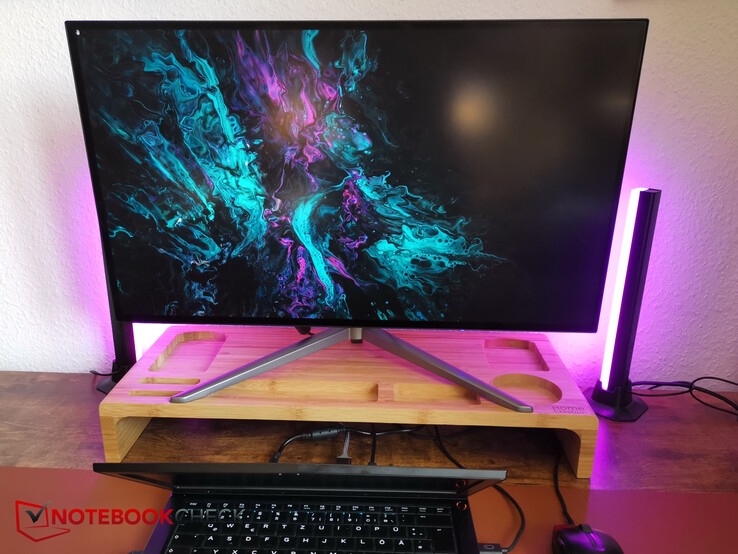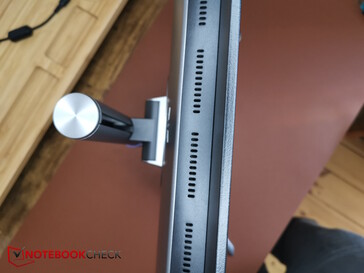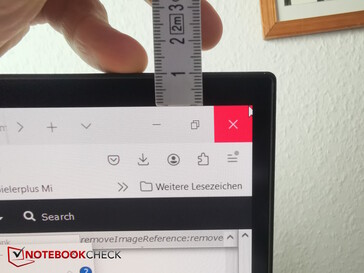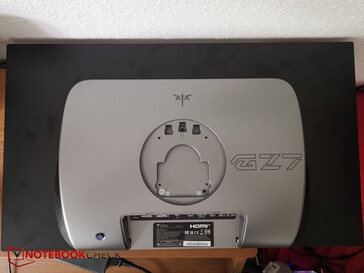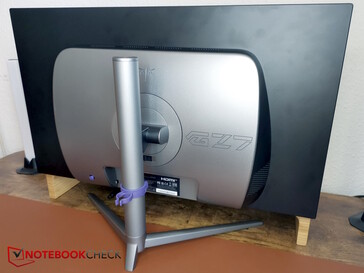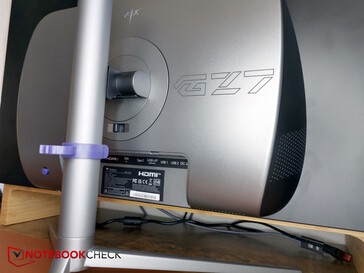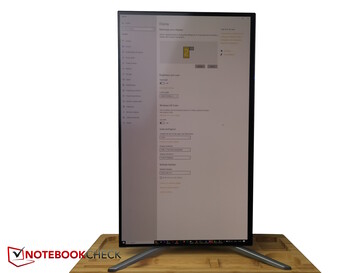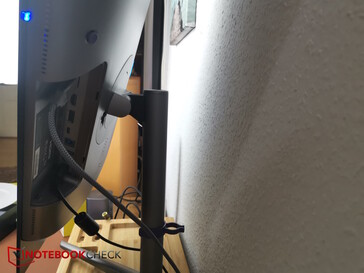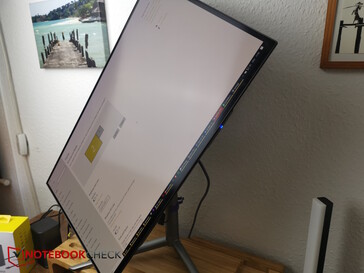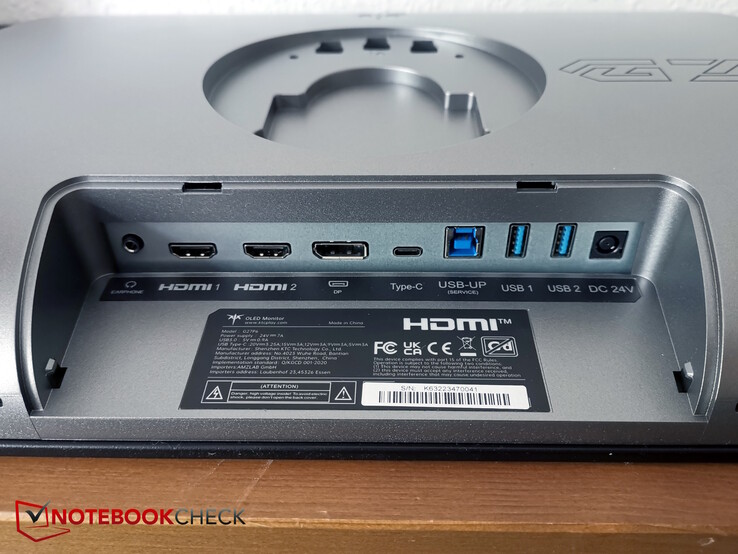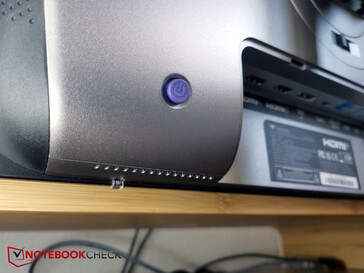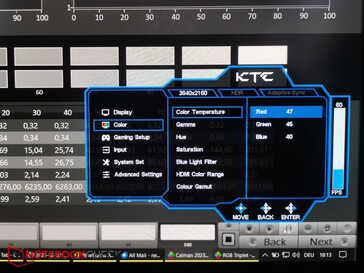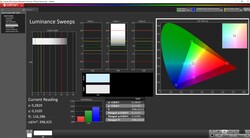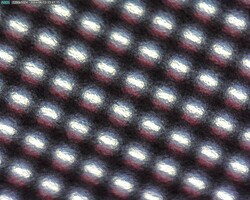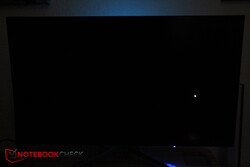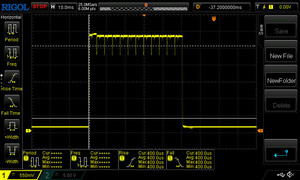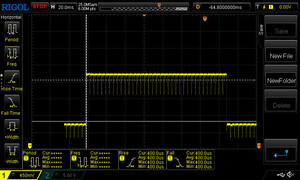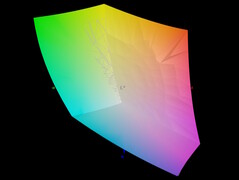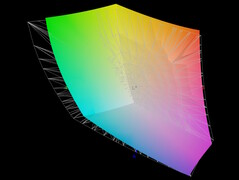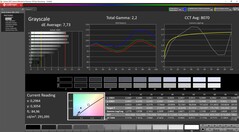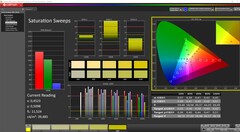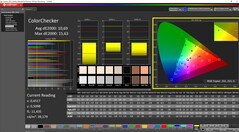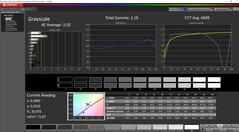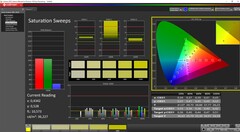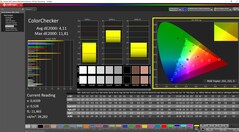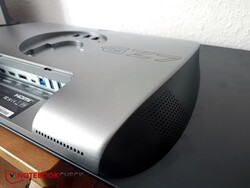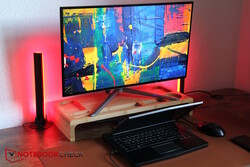KTC G27P6 gaming monitor review: High-contrast 27-inch OLED for €599.99
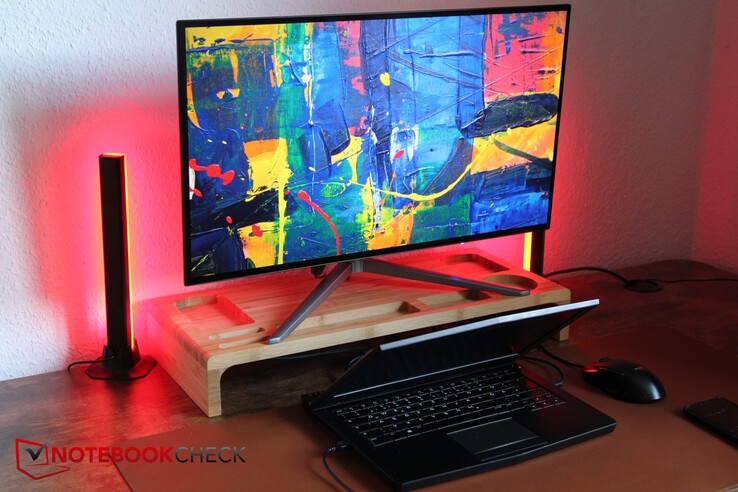
KTC offers various 27-inch gaming monitors on Geekmaxi, with VA, IPS, and MiniLED panels. However, the latest model is an OLED and, at around 640 euros, is also the most expensive of the KTC monitors on offer. And it is precisely this OLED gaming monitor that we are testing today.
Disclaimer: The model currently can also be found for 699 euros at Amazon.com (timely offer, original price is 799 euros).
Features and specifications: 240 Hz OLED with KVM switch
According to the manufacturer, the OLED panel comes from LG and has a resolution of 2,560 x 1,440 pixels. The refresh rate is up to 240 Hz. Speakers are built-in, and there is also an integrated KVM switch that allows two PCs to be used on the monitor via a single set of input devices.
Please note: A refresh rate of 240 Hz is only possible via DisplayPort cable; only 144 Hz is possible via HDMI cable. However, a DP cable is included, but an adapter to MiniDP is not.
We connected a mouse to the monitor to test the KVM switch functionality. As soon as a laptop is connected to the monitor via USB-C or USB-Up, it can be controlled via this shared input device. However, no USB-Up cable for a second computer is included, so you have to have a cable yourself if you really want to use the switch with two devices. In addition, the mouse often stalled or froze on the screen for short or even longer periods, even on the second USB-A port, which was extremely annoying.
Are you a techie who knows how to write? Then join our Team! Wanted:
- News Writer
Details here
| Features | KTC G27P6 |
|---|---|
| Size | 27 inch |
| Panel | LG OLED |
| Resolution | 2560 × 1440P @240Hz |
| Brightness | 450 Nits |
| Coating | Anti-Reflection Hard Coating |
| Contrast | 1.500.000 : 1 |
| Color depth | 10 bit, 1.07 million colors |
| Color space | 92 % Adobe RGB CIE1976, 97 % DCI-P3, 100 % sRGB |
| Response time | 0.03 ms (GTG) |
| Adaptive Sync | FreeSync and G-Sync compatible |
| Connections | 2 x HDMI 2.0 (2560x1440@144Hz), 1 x DP1.4 (2560x1440@240Hz), 1 x Type-C DP Alt Mode (3840x2160@144Hz) (PD3.0 65W), 1 x USB3.0 (upstream port), 2 x USB3.0 (downstream port), 1 x audio output |
| Speakers | 2x 5 W stereo |
| HDR | HDR 10 |
| KVM switch | Yes |
| VESA | 75 x 75 mm |
| Weight | 5.2 kg (4.5 kg without stand) |
| Accessories | 1 x HDMI cable, 1 x DP cable, 1 x Type-C cable, 1 x power cable, 1 x adapter |
| Price | 649,99 Euro |
| Shoplink | Geekmaxi |
Assembly: Super simple, without any screws
Package contents
Assembly
As usual, the display and stand come disassembled in the package, so you have to put them together. This is particularly easy in the case of the KTC G27P6. Instead of screws, the stand is attached to the VESA mount (75 x 75) and hooked on with a sliding bracket. Only the base of the stand is screwed on, but here you simply turn the integrated wing screw on the underside of the base.
The housing is mainly made of plastic. Only the stand is largely made of metal. The monitor is extremely flat towards the edges, as the glass panel is only covered by a very thin, black plastic layer at the back. The plastic edge is only 2 mm thick at the sides. Nevertheless, the general edges of the screen are slightly wider, as the glass panel itself still has a black edge (approx. 6-7 mm).
The other components of the monitor is then located at the back in a plastic box up to 5 cm thick, making the monitor, which is very thin at the edges, thicker towards the middle. This is also where the speakers are located on the sides.
The display is black, the cover of the box-like, central rear is silver, as is the stand. Incidentally, the latter integrates various adjustment options: This allows you to adjust the height of the display, you can swivel it to the right or left and even rotate it so that you can easily use the screen in portrait mode.
However, the movable VESA mount is also the weak point of the case in terms of quality. When the hinge is moved, it almost sounds like thick, crackling plastic foil. The monitor also wobbles when adjusted. In everyday use, however, everything is sufficiently stable.
Connections: HDMI only supports 144 instead of 240 Hz
Unfortunately, the two HDMI outputs only officially support the native resolution of 144 Hz. The DisplayPort connection is different, as it supports 2560 x 1440 at 240 Hz. There is also USB-C with support up to UHD and 144 Hz. Windows actually lets us select a resolution of 3840 x 2160, but this is not available in games. However, we found this out via HDMI cable. The USB-C port supports Power Delivery with up to 65 W, so you can also operate devices via the monitor power supply, for example, an economical office laptop.
The connections are all located at the back on the underside of the "technology box".
User interface: Joystick with gimmicks
A small joystick on the bottom right-hand side of the monitor serves as a control element. The different directions of the joystick also serve as quick links to the most important settings. If you press the joystick down, for example, you can change the brightness directly.
However, the monitor's main menu can be opened by pressing the stick. In addition to the usual settings, there is also a gaming menu in which you can activate a crosshair in the middle of the screen, a timer, adaptive sync, or improve the input lag.
Display: Great contrast, weak factory calibration
There is only one preset in the settings: Standard. The brightness is lowered to 40 percent in this preset. Measuring the brightness is not easy as it is automatically adjusted by ABL.
In the standard preset, 40 percent brightness and a completely white screen, we measure a maximum brightness of 320 nits in SDR mode in the center of the screen. If we reduce the brightness window to just 2 percent, we can still measure around 400 nits. However, as our measuring device is not designed for such small display windows, we cannot say with certainty whether the 450 nits will be fully utilized. We did not get any higher brightness values in HDR mode.
The black level of 0.02 is typically low for OLEDs, but this also depends heavily on the display device. On our first laptop and with a preset gamma value of 2.2, the picture looked OLED-typically pale. A change to a gamma of 2.4 can already help. Overall, the default settings are not optimal. Our ICC profile can be downloaded free of charge above.
The response times are very fast, the organic LEDs illuminate the monitor evenly and in terms of flickering we only measure the refresh rate.
| |||||||||||||||||||||||||
Brightness Distribution: 93 %
Contrast: 16000:1 (Black: 0.02 cd/m²)
ΔE Color 10.69 | 0.5-29.43 Ø4.99, calibrated: 4.11
ΔE Greyscale 7.73 | 0.57-98 Ø5.2
86.86% AdobeRGB 1998 (Argyll 2.2.0 3D)
99.23% sRGB (Argyll 2.2.0 3D)
86.91% Display P3 (Argyll 2.2.0 3D)
Gamma: 2.2
| KTC G27P6 OLED, 2560x1440, 27.00 | MSI MAG 274UPF MAG 274UPF, IPS, 3840x2160, 27.00 | Samsung Odyssey Neo G7 VA, 3840x2160, 32.00 | MSI Optix MAG274QRX IPS, 2560x1400, 27.00 | |
|---|---|---|---|---|
| Display | 4% | 4% | ||
| Display P3 Coverage | 86.91 | 92.47 6% | 87.5 1% | |
| sRGB Coverage | 99.23 | 99.26 0% | 99.9 1% | |
| AdobeRGB 1998 Coverage | 86.86 | 92.6 7% | 96.3 11% | |
| Response Times | -858% | -654% | ||
| Response Time Grey 50% / Grey 80% * | 0.8 ? | 8.89 ? -1011% | 6.23 ? -679% | |
| Response Time Black / White * | 0.8 ? | 6.44 ? -705% | 5.83 ? -629% | |
| PWM Frequency | 240 | |||
| Screen | -198% | 32% | -180% | |
| Brightness middle | 320 | 393 23% | 338.36 6% | 351 10% |
| Brightness | 310 | 350 13% | 336 8% | 329 6% |
| Brightness Distribution | 93 | 81 -13% | 89 -4% | 89 -4% |
| Black Level * | 0.02 | 0.38 -1800% | 0.33 -1550% | |
| Contrast | 16000 | 1034 -94% | 1064 -93% | |
| Colorchecker dE 2000 * | 10.69 | 6.28 41% | 3.8 64% | 7.28 32% |
| Colorchecker dE 2000 max. * | 15.63 | 10.29 34% | 8.1 48% | 16.15 -3% |
| Colorchecker dE 2000 calibrated * | 4.11 | 3.7 10% | 1.5 64% | 3.61 12% |
| Greyscale dE 2000 * | 7.73 | 7.3 6% | 4.7 39% | 10.3 -33% |
| Gamma | 2.2 100% | 2 110% | 2.43 91% | 2.15 102% |
| CCT | 8070 81% | 7896 82% | 6583 99% | 9378 69% |
| Total Average (Program / Settings) | -351% /
-249% | 32% /
32% | -277% /
-208% |
* ... smaller is better
Display Response Times
| ↔ Response Time Black to White | ||
|---|---|---|
| 0.8 ms ... rise ↗ and fall ↘ combined | ↗ 0.4 ms rise | |
| ↘ 0.4 ms fall | ||
| The screen shows very fast response rates in our tests and should be very well suited for fast-paced gaming. In comparison, all tested devices range from 0.1 (minimum) to 240 (maximum) ms. » 1 % of all devices are better. This means that the measured response time is better than the average of all tested devices (21.4 ms). | ||
| ↔ Response Time 50% Grey to 80% Grey | ||
| 0.8 ms ... rise ↗ and fall ↘ combined | ↗ 0.4 ms rise | |
| ↘ 0.4 ms fall | ||
| The screen shows very fast response rates in our tests and should be very well suited for fast-paced gaming. In comparison, all tested devices range from 0.2 (minimum) to 636 (maximum) ms. » 1 % of all devices are better. This means that the measured response time is better than the average of all tested devices (33.5 ms). | ||
Screen Flickering / PWM (Pulse-Width Modulation)
| Screen flickering / PWM detected | 240 Hz Amplitude: 14 % | ||
The display backlight flickers at 240 Hz (worst case, e.g., utilizing PWM) . The frequency of 240 Hz is relatively low, so sensitive users will likely notice flickering and experience eyestrain at the stated brightness setting and below. In comparison: 53 % of all tested devices do not use PWM to dim the display. If PWM was detected, an average of 17673 (minimum: 5 - maximum: 3846000) Hz was measured. | |||
Color space
Color accuracy
The monitor is extremely poorly calibrated in the factory default settings. Although there are presets for the most important color spaces in the monitor menu, we also measured quite high deviations here.
Fortunately, manual calibration using our X-Rite i1Pro and the Calman software can tease out significantly better values. The deviation in the greyscales drops from over 7 to just 2, while the deviations in the ColorChecker improve, but are still quite high at over 4. The gamma curve shows an inexplicably sharp drop at 80 to 90 percent white in virtually all settings.
Speakers: Weak 5W stereo
KTC installs two 5 W stereo speakers. These are located at the rear and radiate to the sides. However, they are of poor quality.
We took measurements at a typical sitting distance of approx. 60 to 65 cm from the monitor. The maximum volume proves to be too low, and basses are almost non-existent, but the mids and highs are at least balanced.
The speakers are not very suitable for listening to music. At least the G27P6 has a headphone output.
KTC G27P6 audio analysis
(-) | not very loud speakers (71.04 dB)
Bass 100 - 315 Hz
(-) | nearly no bass - on average 15.2% lower than median
(-) | bass is not linear (17.8% delta to prev. frequency)
Mids 400 - 2000 Hz
(+) | balanced mids - only 2.2% away from median
(+) | mids are linear (5.7% delta to prev. frequency)
Highs 2 - 16 kHz
(+) | balanced highs - only 2.8% away from median
(+) | highs are linear (4.3% delta to prev. frequency)
Overall 100 - 16.000 Hz
(±) | linearity of overall sound is average (16.8% difference to median)
Compared to same class
» 25% of all tested devices in this class were better, 7% similar, 68% worse
» The best had a delta of 4%, average was 25%, worst was 134%
Compared to all devices tested
» 25% of all tested devices were better, 7% similar, 68% worse
» The best had a delta of 4%, average was 25%, worst was 134%
Power consumption - Depends on the content
The consumption of an OLED varies greatly depending on the brightness and content displayed. If you want to save energy, activate dark themes in Windows and the like.
When switched off, the G26P6 still draws between 26 and 90 mW from the socket. At maximum brightness and a fairly white browser display, it consumes around 40 to 45 W. If you reduce the brightness to the standard 40 percent, the consumption drops to around 30 W. If you watch a darker movie at full brightness, 23 to 30 W are consumed.
| Brightness/measured value | 100 % brightness | 40 % brightness |
|---|---|---|
| Bright browser window | 40 - 45 W | 30 W |
| Dark movie (The Mayor of Kingstown) | 23 - 30 W | 21 - 26 W |
| Off/Standby | 20 -100 mW |
Pros
Cons
Verdict - Gaming OLED
The KTC G27P6 does exactly what it is designed for: it is primarily suitable as a gaming monitor. This is ensured by the very fast response times, the deep black, and the great OLED contrasts. Added to this is the versatile adjustability.
However, the 27-inch screen is not necessarily suitable for creators, as the color deviations are still too high even when calibrated, not to mention the weak delivery status in this respect. The speakers could also be much better.
The KTC G27P6 is a gaming monitor through and through: KVM switch, fast response, and the typical OLED advantages in terms of contrast. The somewhat lacking color accuracy might put off creators, but gamers can go for it.
Price and availability
The manufacturer KTC is asking 899 euros ($963) for the monitor on its website. Users can also order the monitor via Amazon. Geekmaxi sells the OLED for 639.99 euros: the company has sent us an exclusive voucher code (G27P6NBC), which reduces the price to 599.99.
Transparency
The present review sample was given to the author by the manufacturer free of charge for the purposes of review. There was no third-party influence on this review, nor did the manufacturer receive a copy of this review before publication. There was no obligation to publish this review.


 Deutsch
Deutsch English
English Español
Español Français
Français Italiano
Italiano Nederlands
Nederlands Polski
Polski Português
Português Русский
Русский Türkçe
Türkçe Svenska
Svenska Chinese
Chinese Magyar
Magyar